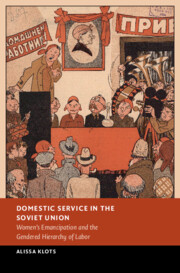Book contents
- Domestic Service in the Soviet Union
- New Studies in European History
- Domestic Service in the Soviet Union
- Copyright page
- Contents
- Figures
- Acknowledgments
- Introduction
- Prologue
- Part I Servants into Workers, 1920s
- Part I Introduction
- Chapter 1 From Exploitation to Socially Useful Labor
- Chapter 2 Just Like Any Other Worker? Class, Gender, and Labor Rights
- Chapter 3 Kitchen Maids in the School of Communism
- Chapter 4 The New Soviet Domestic Worker
- Part I Conclusion
- Part II In the Land of Victorious Socialism, 1930s–1950s
- Conclusion
- Bibliography
- Index
Chapter 1 - From Exploitation to Socially Useful Labor
The Early Soviet Discourse on Domestic Service
from Part I Introduction
Published online by Cambridge University Press: 25 April 2024
- Domestic Service in the Soviet Union
- New Studies in European History
- Domestic Service in the Soviet Union
- Copyright page
- Contents
- Figures
- Acknowledgments
- Introduction
- Prologue
- Part I Servants into Workers, 1920s
- Part I Introduction
- Chapter 1 From Exploitation to Socially Useful Labor
- Chapter 2 Just Like Any Other Worker? Class, Gender, and Labor Rights
- Chapter 3 Kitchen Maids in the School of Communism
- Chapter 4 The New Soviet Domestic Worker
- Part I Conclusion
- Part II In the Land of Victorious Socialism, 1930s–1950s
- Conclusion
- Bibliography
- Index
Summary
Chapter 1 analyzes the shift in the understanding of domestic service from a problematic institution intrinsically connected to inequality and exploitation to an acceptable practice in the 1920s. These early conversations revealed the two main tensions in the understanding of paid domestic labor after the revolution. The first involved class. While quick to reimagine domestic servants as domestic workers, the Bolsheviks struggled to articulate a coherent position on the class affiliation of their employers. Even though employment of household workers did not constitute exploitation in the strictly Marxist sense, the practice had a distinctly petty-bourgeois character in the eyes of many Soviet citizens. The second tension had to do with gender. The Bolsheviks had no resources to fulfil their vision of socialized housework but still sought to mobilize urban women for work outside the home and for political life. Rather than encouraging redistribution of labor in the home, the state saw employment of female migrant peasants with no professional qualifications in Soviet homes as an acceptable solution to the problem of housework.
- Type
- Chapter
- Information
- Domestic Service in the Soviet UnionWomen's Emancipation and the Gendered Hierarchy of Labor, pp. 35 - 63Publisher: Cambridge University PressPrint publication year: 2024



